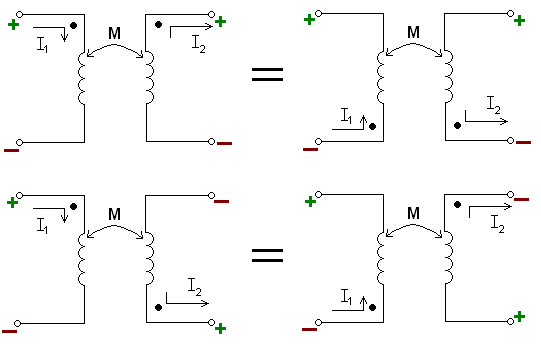Polarity (mutual inductance)


Instantaneous polarity, commonly called polarity is an electrical term used to denote the relationship of mutual inductances to each other influencing their relative electrical phasing.
A dot marking convention, or alphanumeric marking convention, or both, can be used to denote the same relative instantaneous polarity of two mutually inductive components such as between transformer windings. These markings may be found on transformer cases beside terminals, winding leads, nameplates, schematic and wiring diagrams.
Based on the dot convention, a current entering the dotted terminal of one coil, will induce positive voltage at the dotted terminal of the second coil. Alternatively, if the current leaves the dotted terminal of the coil, it will induce negative voltage at the dotted terminal of the second coil.[1]
Transformer windings
Two methods are commonly used to denote which terminals present the same relative polarity. A dot may be used, or an alphanumeric designation. Alphanumeric designations are typically in the form H1 for primaries, and for secondaries, X1, (and Y1, Z1, if more windings present).
Unlike single-phase transformers, three-phase transformers may incorporate a phase shift due to different winding configurations resulting in a multiple of 30 degree phase shift between H1 and X1 bushing designations.
Terminal layout conventions
Referring to the circuit diagrams below:
- The circuit polarity signs '+' and '-' indicate example applied and resultant, relative voltage polarities.
- The instantaneous polarities of the voltages across each inductor with respect to the dotted terminals are the same.[2]
- The circuit arrows indicate example applied and resultant relative current directions.
- The instantaneous directions of the current entering the primary inductor at its dotted end and the current leaving of the secondary inductor at its dotted end are the same.
- Subtractive polarity transformer designs are shown in the upper circuit diagrams. Additive polarity transformer designs are shown in the lower circuit diagrams.[3]
Autotransformers
If two mutually coupled inductors are in series, the dot convention can be used in the same manner as in the case of autotransformers. Relative polarity in autotransformer drawings is usually quite obvious by physical placement of the windings in circuit drawings.
See also
References
- ↑ Alexander 2009, p. 559–560.
- ↑ "PS-E-15 — Provisional Specifications for Approval of Electronic Voltage Transformers". Measurement Canada. Retrieved 18 April 2013.
- ↑ "Transformer Polarity". .idc-online/electrical_engineering. Retrieved 23 April 2013.
Bibliography
- Alexander, Charles (2009). Fundamentals of electric circuits. McGraw-Hill. ISBN 0073529559.
- ANSI/IEEE C57.13, American National Standard Requirements for Instrument Transformers
- Brenner, Egon; Javid, Mansour (1959). "§18.1 'Symbols and Polarity of Mutual Inductance' in Chapter 18 - Circuits with Magnetic Circuits". Analysis of Electric Circuits. McGraw-Hill. pp. 589–590.
- Boylestad, Robert L. (2003). "Section 21.8: Series connection of mutually coupled coils". Introductory Circuit Analysis (10th ed.). Prentice Hall. p. 954. ISBN 0-13-097417-X.
- Kothari, D.P.; Nagrath, I.J. (2010). §3.7 'Transformer Testing' in Chapter 3 - Transformers (4th ed.). Tata McGraw-Hill. p. 73. ISBN 978-0-07-069967-0.
- Parker, M. R; Ula, S.; Webb, W. E. (2005). "§2.5.5 'Transformers' & §10.1.3 'The Ideal Transformer'". In Whitaker, Jerry C. The Electronics Handbook (2nd ed.). Taylor & Francis. pp. 172, 1017. ISBN 0-8493-1889-0.
